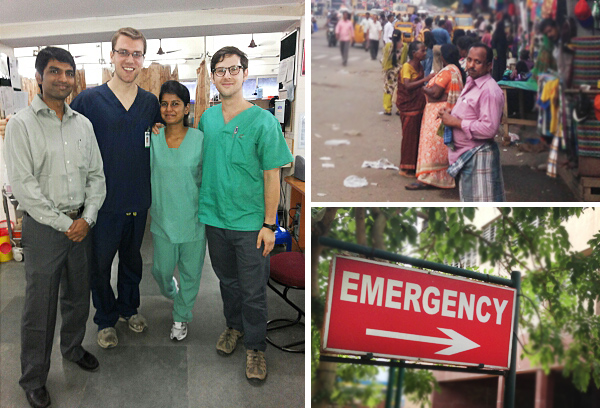
The author at Sundaram Medical Foundation’s ER. Standing (left to right): Dr. Tausif Thangalvadi, the author, Dr. Mathu Santhakumar, and Jesse Berman. Also shown, photos of Chennai, India by the author.
For five weeks in the summer of 2013, I had the incredible opportunity to live, work and immerse myself in the culture of Chennai, India.
Upon arrival, I was a bit overwhelmed. This really is a “developing” country.
Despite the booming Indian economy, the local infrastructure appeared lacking. A common sight: the sick and homeless on the street, sweltering in humid 97-degree heat. Traffic lights were a rare sight, and vehicle traffic operated to the constant drone of honking.
I slowly became accustomed to the stares of strangers, who seemed surprised to see a person with white skin, blond hair and blue eyes. I learned quickly, though, that the reaction to me was one of curiosity. A simple smile and “hello” on my part would almost always result in a friendly, endearing smile, along with an earnest attempt at an English greeting. The people I met seemed to love Americans, and during my trip were always there to help if needed.
I traveled to Chennai to conduct clinical research on triage in the emergency department (ED). My classmate Jesse Berman and I had both received Global Health Fellowships from Einstein to help fund the project. Conversations with Einstein alumnus Dr. Kumar Alagappan led us to Dr. Pari Rajavelu, the head of the emergency department at Sundaram Medical Foundation (SMF) in Chennai.
Over the months prior to our trip, Jesse and I developed a research plan. We arrived several days after our first-year final exams, eager to tackle the question of how to provide triage (the cornerstone of initial management) efficiently and effectively in resource-poor emergency departments.
Several triaging systems currently exist worldwide, yet only a few have been studied and validated sufficiently. SMF, the Chennai hospital, like nearly 60 percent of hospitals in the U.S., uses the Emergency Severity Index (ESI) to prioritize patients.
ESI is a five-level scale that places patients into different tiers based on the acuity of the disease and the number of ED resources expected to be used. Thus, it is a subjective system; it relies upon experienced nurses to predict resource usage for presenting patients. This is an exceedingly difficult task, especially in short-staffed hospitals that are forced to keep their more experienced nurses within the ED and not in triage.
An alternative, the Modified Early Warning Score (MEWS), is increasingly being used as a triage tool. MEWS was originally developed for monitoring inpatient status; it is now being modified for triage use. Recently, South Africa adopted a modified MEWS—the South African Triage Score—as its national triage protocol. MEWS relies on vital parameters to calculate a numeric score and is a more objective tool than ESI.
Jesse and I worked with an emergency-medicine resident, Ranjit Sam, to carry out the project. The goals of the study were to validate and compare ESI, the more subjective triage protocol, with MEWS, the more objective one. Additionally, we set out to find a way to blend the two scoring systems, taking the best from each.
Ultimately, we hope to provide less experienced triage nurses with a tool that will aid them in effectively triaging patients to the ED. We collected relevant data on roughly 1,000 patients who presented to the ED over a 30-day period, and we are still working with a biostatistician to analyze the data.
Most of our days were spent in the emergency department. SMF has a 14-bed ED located in Anna Nagar, Chennai, that sees 18,000 to 20,000 patients a year. Diabetes, tuberculosis and malaria were frequently observed within the patient population.
It was interesting to observe and learn how healthcare works in India. The cost of treatment in U.S. dollars seems quite low. For example, the price of an ED consultation is about 200 rupees ($3.30)—about the same cost as two beers and a loaf of bread. Because only the wealthy can afford medical coverage, most people pay out-of-pocket costs at a billing desk located at the center of the ED.
I’m excited to see our research project to completion. I’ve also taken stock of this incredible global health experience.
It’s remarkable how five weeks in an exotic land can change your frame of reference. When I arrived in India, it seemed to move at an almost sleepy pace, despite the dense concentration of people. Yet when I returned home to the Bronx, I found myself missing my daily strolls and interactions. I fondly miss the quirks of South India. I now long to experience again things that were at first difficult and troublesome.
My experience had an impact on the way I view the world. I feel more well rounded and open minded, more of a global citizen. This can only help my future career as a physician and the patients I’ll serve.

